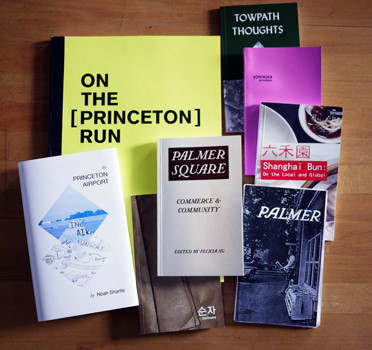In ”Princeton Places” Lewis Center Students Offer Local Impressions Through Graphic Arts


ASPECTS OF PRINCETON: “Princeton Places,” a project Lewis Center visiting faculty member Danielle Aubert suggested to students in her fall 2014 advanced graphic design class, will be introduced February 11 at a 6 p.m. presentation and discussion at the Princeton Public Library.
Teaching at Wayne State University in Detroit, graphic artist Danielle Aubert often met fellow artists visiting the city to do projects about its abandoned buildings and urban blight. While she admired their efforts, she wondered what it would be like for budding artists who actually lived there to express their ideas about the city.
Currently a visiting Fellow in the Creative and Performing Arts at Princeton University’s Lewis Center for the Arts, Ms. Aubert suggested a similar idea to students in her fall 2014 advanced graphic design class. The result, a book called Princeton Places, will be introduced February 11 at a 6 p.m. presentation and discussion at the Princeton Public Library.
The eight students interpreted such sites as Palmer Square, Princeton Running Company, the Princeton Airport, and the Delaware and Raritan Canal Towpath, varying widely in their use of methods and materials. “I wanted to do something in Princeton that was useful for students to get to know the community, and graphic design is an interesting way to do it,” said Ms. Aubert. “You can pull together so many different materials. There are a lot of ways to represent a place.”
The students were asked to choose a site to examine and represent as a book using the tools of graphic design. They employed images, maps, interviews, writings, and archival materials. Simon Wu used photographs of food he ordered at Soonja’s Cafe to talk about the restaurant on Alexander Street. Neeta Patel’s photos and printed interviews were her interpretation of Princeton Running Company. Felicia Ng used historic photos, maps, and text to talk about the displacement of an African-American neighborhood to make way for the development of Palmer Square. Andrew Sonderm also chose Palmer Square, but took a different approach.
“Two of the students did projects on Palmer Square. They looked at interesting sides of it,” Ms. Aubert said. “One mapped out all of the stores from decade to decade, but you see them moving around within the square. Another one was an interview with someone who lives in Palmer Square.”
Ms. Aubert decided it was important to focus on locations that were easily accessible for the students, because she knew multiple visits and detailed exploration would be part of the project.
“When I started thinking about this, I knew that New Jersey was marking the 350th anniversary of its naming, so I considered telling the students they could go anywhere in New Jersey,” said Ms. Aubert. “But the more I thought about it, I realized I wanted them to be able to visit the sites multiple times, and have their own relationships to the sites so they were not just visiting or thinking of it as an outsider. The one rule was that it had to be off campus. I told them to pick a street, a shop, or whatever, focusing on a place that was lively and not necessarily a historical site.”
Asked for her favorites, Ms. Aubert was diplomatic. “I thought they were all interesting,” she said. “I did really enjoy reading the one by Angela Zhou about Shanghai Bun, the restaurant in Princeton Junction. I thought it was interesting because it brings in a sort of global angle. And in her book, she talks about her own relationship to the restaurant, which is a little bit surprising.”
As part of the project, each student created his or her own book. Princeton Places is made up of excerpts from those
individual publications.
Ms. Aubert is no stranger to using graphic design for a book. “I actually co-edited a book about my neighborhood in Detroit,” she said. “It’s called Thanks for the View, Mr. Mies: Lafayette Park, Detroit. It guided me a lot with this project, in terms of what I was asking them to come up with. To gather all the material and edit and design it is a big project. No one is telling you ‘You can’t put that in your book.’ It’s a big undertaking.”
The book launch of Princeton Places is at 6 p.m. on Wednesday, February 11, at Princeton Public Library.

